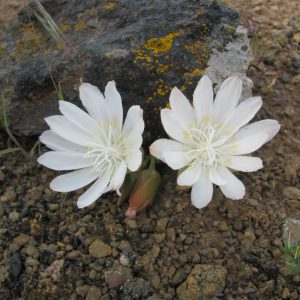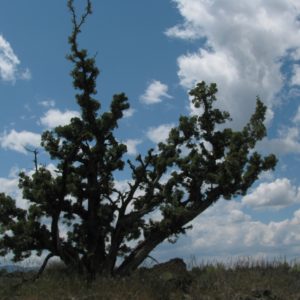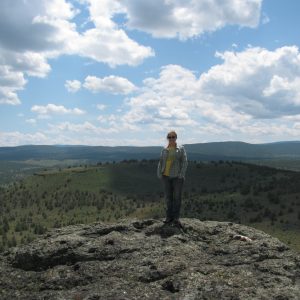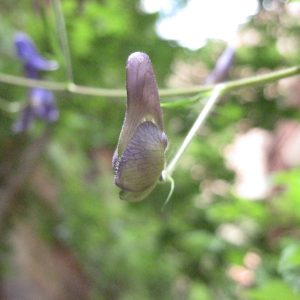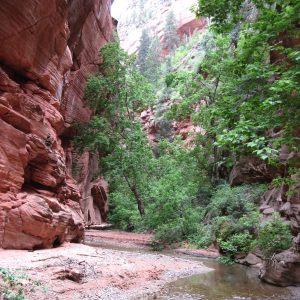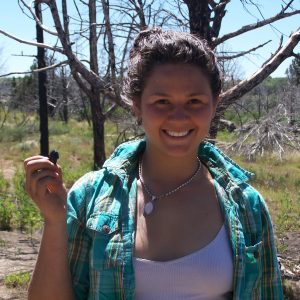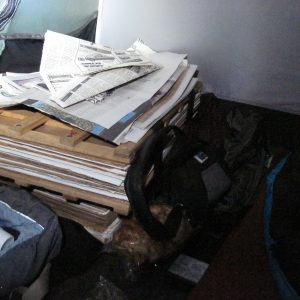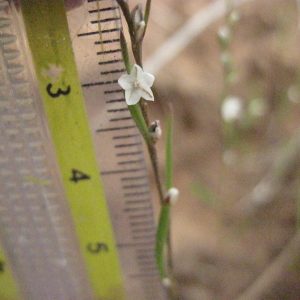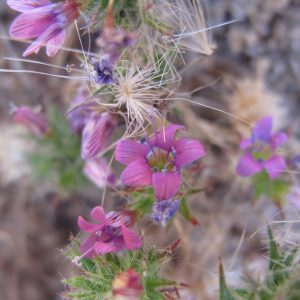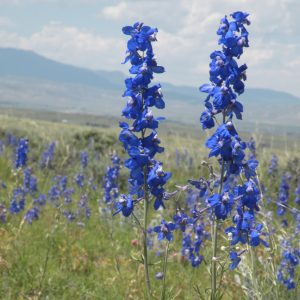The weeks have been flying by. This past Wednesday marks my fifth week in Cedarville. Much has happened in these few weeks; I have become acquainted with many projects that are conducted by the BLM. My third week of work began by traveling to Chicago from San Francisco. The week spent in Chicago at the Chicago Botanic Garden was wonderful. The workshop in Chicago gave me the opportunity to meet two other interns at the Alturas office twenty miles away. On Wednesday myself and the other two SOS interns from Alturas went out with a crew from the Forest Service to conduct vernal pool surveys. The following morning we were able to help out at our neighboring National Wildlife Refuge by conducting duck brood surveys. It is rewarding to start work early in the high desert because then fewer hours are spent in the hot afternoon sun. I am beginning to get a handle on my project. I have scouted out many populations that will be ready for seed collection in the coming weeks and have already made a few collections of species that are currently ready for collection. I can navigate myself around this region much more successfully now that I have done some seed scouting. In addition I am becoming confident in my ability to recognize and identify many of the species that are present in this area.
The high desert is more and more intriguing every day. The vast landscape appears to be homogenous throughout but once a closer look is taken it can be seen that the geology changes drastically over short distance. The geology largely affects the type of vegetation that will flourish in this dry climate; the soil type is often reflected in the variety of sage that is abundant at a particular site. Another quality the desert embodies that I find soothing is the constant hum of insects in the air. In some areas, often times surrounding riparian areas, while conducting a seed collection I am accompanied by the most beautiful fluttering butterflies. I had the opportunity to visit blue lake which is located just on the other side of the Warner Mountains. The area surrounding the lake burned in a wild fire a few years ago. I had never seen the beautiful destruction that a fire can cause. Awe struck is the appropriate way to describe how I felt. I am nearing half way, and aim for a new experience every day!
Monthly Archives: July 2011
Basin v. Range
This is Justin checking in from Carson City BLM. From a distance the entire Great Basin may look like one big xeric wasteland, but it most certainly is not. Well, the basin half comes close with just 5 inches of annual precipitation. But a week in the field on rangeland survey revealed plant diversity in the basins. And the mountains ranges are just teeming with life. My fieldwork notes are beginning to be dotted with memos saying, “return to ______ Mountains next weekend.”

So far I am enjoying the company of my coworkers. Like America’s population, the staff of the BLM are beginning to age. This is great for me because I hear humorous stories accumulated through years of working for the fed. They are also experts on their locals and make learning new ecosystems and management practices far easier than reading a book. I’m also lucky to be stationed in a field office with 6 other CLM interns, leading the old-timers to lament the “under-30 invasion.” That’s all for now!

Adventures in Seed Collection
We arrived back in the office after a week in Chicago and a long holiday weekend only to find out that our mentor was being sent to a fire in New Mexico to help with the mitigation of post-fire effects. We had just had our Seeds of Success training at the Chicago Botanic Garden and were ready to get to work collecting seed, so we assured our mentor that we would find plenty to do in his absence. I was pleased that he would be working in my home state in the Jemez Mountains, where I had spent nearly every summer of my childhood escaping the heat of Albuquerque, but I was disappointed that we would not be able to go out in the field with him.
This past week on a seed scouting trip, we were able to experience the crazy weather that makes field work in the Western US so exciting and dangerous. We went to a site that our mentor had told us about that was fairly close to our field office in Alturas. Several people in our office warned us about the terrible road conditions where we were headed, so we allowed plenty of time to get there. It is good that we had been warned, because it took us nearly an hour to go the three miles to get to an old ranch house from the county road. We were constantly thrown around by the large rocks that made up the road, and when we stopped, it felt good to put my feet on solid ground. We parked and hiked past the ranch house, up a hill and into the forest. We looked for species to collect, and took herbarium voucher samples for those that were now flowering. It was a very pleasant hike through the trees and we walked along a small creek for much of the way. After lunch we headed back to the truck, collecting the seed of another species of grass along the way. We decided to drive a bit further to check out a spring that was just off the road.. While looking at the plants around the spring, it began to sprinkle. After a few minutes, it stopped raining and we assumed that it had passed over, but instead, it began to rain again. It started raining harder and harder, so we headed back to the truck (where of course we had left the windows down) to drive back to the office. Soon it was pouring rain and the road that had been hard-packed with big rocks to drive over became oozing mud with big rocks mixed in. We drove through pockets of hail that was so thick that we had to stop and wait for it to pass, and then back into the rain, which continued relentlessly. The thunder was deafening and seemed to make the truck shake even more on the bumpy roads. There were some close calls through some long sections of pure mud, but I was determined not to get stuck. After a very stressful hour and a half, we were back to the county road where it had not rained a drop. I stepped out of the truck to let my partner drive the rest of the way to the office, and could hardly straighten my back from being bent forward for so long. I stretched out my hands to release the tension that had built up from clenching the steering wheel like a lifeline, and plopped into the passenger’s seat, thoroughly exhausted. On the drive back, I found myself with a smile that would not go away. We had certainly had an adventure-filled day of seed collection! I was ready for another adventure the next day, but more than that, I was ready for a long night’s sleep in my bed.
Forces of Nature
As many recent college graduates, I spent the last four years staring at computer screens, huddling over books, and idling in classrooms. Though I dedicated countless hours to reading and writing about the natural world, only a fraction of my time was spent experiencing it. My life was governed by arbitrary deadlines and sustained by florescent light bulbs. The last few weeks have been the exact opposite. As a Seeds of Success intern I have been jolted back to reality; the reality in which the world runs on the sun’s clock and life succumbs to the forces of nature.
“No, no, it’ll be dry here. Vale is in the desert, the hot, hot, desert” Gillian, my mentor, mentioned before my trip out from Colorado. Shorts, tank tops, and sandals all flew into my trunk in large numbers. I threw in one warm hat, a rain jacket, and a few pairs of old jeans, just to be safe. Three weeks later, sopping wet from the snow and muddy to my knees, I thought of my large brimmed sun hat still untouched in the trunk of my car. Faintly, over the gusts of wind I heard the familiar “No, no, seeds still not ready” from the others.
Three weeks of persistent rain, cold, and wind not only affected my choice of clothing each morning it also affected every aspect of our SOS goals. In mid-June most of our potentially collectable plants had only slightly matured, if at all. For three weeks our team, 3G, waited, watched, and wished for the sun to come out so our plants could start going to seed.
Finally the clouds parted and gave way to full days of sunshine and warmth. Giddy and excited we reassessed which populations would be ready first. Balsamorhiza sagitata moved to the top of the list. Driving to the site, I was excited for my first full day of seed collecting. We got out of our rig, hiked to the exact location and…nothing. Looking closer we spotted the large, sagittate basal leaves. Disappointed and confused we walked back to the car hardly noticing the dozens of cows happily munching on our Balsamroot seeds.
Though my days often end with mosquito bites on my legs, ticks in my clothes, and sunburned shoulders, the daily blast of air conditioning at the office reminds me how lucky I am to have a job so interwoven with nature.
I might be in heaven
Life becomes complicated when you are having so much fun that work and fun become inseparable. Can I really call hiking around spectacular places looking for beautiful mysterious plants work? That is way too much fun. I feel almost guilty at enjoying myself so thoroughly hiking from one valley to the next, one canyon to another. These last two weeks have been epically busy. First I had to work through inordinate amounts of data to find out what species are in Dakota Hills that have already been collected. Dakota Hills are in the far north east of Zion National Park. In 2007 there was a massive fire, thus changing the ecosystem quite a bit. The archaeology department at Zion National Park invited me to come along on a four day trip to Dakota Hills. I, of course, quickly said yes. Passing up opportunities to go wonderful new places is out of the question. To get to Dakota Hills was a mission in itself; we road on BLM land with horses for two hours until we finally made it to the park boundary. We bade our farewells to our cowboys and set up camp among burnt Pinus ponderosa, Juniperus osteosperma and beautiful bunch grasses, Penstemons of various kinds, odd fabaceae, and many jasper flakes Native Americans had left thousands of years ago.
The first day we dedicated to finding out where the archaeological sites where and how to get there. It was lightly raining as thunderstorms continuously rolled in from the south east. The maze of Quercus gambelii felt like a car wash for humans as we bushwhacked out way around countless hills and washes. Finally we found the tributary system upon which the sites were. Throughout all of this hiking, I gathered a good sense of what species were out there and which I had to key.
We got back to camp, ate a quick dinner of pre-made parmesan pasta that would have made my nonna reconsider having me as a granddaughter. Honestly, for camp food it was pretty good. The next two days were an array of hiking crazy amounts, learning the history of the Americas the last 40,000 years, finding amazing projectile points 10,000-8,000 years old AND finding out what EACH plant species up there was. The main archeologist said it was the best trip of his career! My collection is now up to 28 specimens!
It was wonderful to have an inter-departmental cooperation between vegetation and archaeology. I think the two archeologists I went with enjoyed learning the flora of the sites they visited and I lack words to describe how happy and thankful I was learning how to treasure hunt and protect historical patrimony.
My plant collection is still missing all the plant I collected last weekend when I hiked to the most beautiful part of Zion I have yet been. On the far west side, there is a whole array of canyons and valleys that take ones breath away. I was hiking out there for recreational purposes but I knew I was bound to find magical plant species so I brought a small plant press along. I was absolutely right. There were columbines twice the size of the common red and yellow ones we see in the main canyon. There was one absolutely phenomenal Ranunculaceae Aconitum columbianum that is deep purple, on a long raceme. It has a hood, two keel petals, and a morphology that looks more like an orchid than anything else. B E A Utiful. It is rare, and probably at the end of its season, so tomorrow I head out to try to find it again. Find it and the other 20 species out there that are, without a doubt, to live for. The crazy thing is, when I get back, I am going into The Narrows as part of work too! Then is when I start wondering if maybe I died rock climbing and went to heaven where work is the most fun one can possibly have…
- Aconitum columbianum bud
- gorgeous canyons
- found this projectile point, did the right thing and put it back!
- Archaeology is really fun!
- my office (in my tent)
- some of the most beauitful things in life can be measured in mm
Escondido, CA
My first month out of the redwood fog in Northern California has been a great learning experience. Its been great learning the plants of this bioregion, starkly different from where I came, characterized by the chaparral plant community. I am truly grateful to be able to spend my days looking for plants, gathering seed, and cleaning seed. This station is full of motivated people with various projects one can plug into such as cactus wren habitat monitoring and kangaroo rat habitat restoration. I didn’t realize other members of anacardiaceae occured in California, so it was cool to meet the genera rhus and malosma. There are a lot of scenic mountain areas here, more than I thought, in a place I thought was just strip malls and urban sprawl. It is refreshing to note how much biodiversity still exists in San Diego county. I look forward to further exploration of this new, mediteranean-style home.



- Spider seen while collecting seed
- Navarretia atractyloides
- View outside Ramona, CA
Restoration is Difficult Work!
 My internship focuses on restoring Desert Fan-Palm Oases. Apparently, no one has come up with a set way on how to restore desert habitat. There is a lot of collaboration and research into finding techniques to use, to restore this habitat. My favorite method by far is using the Groasis Waterboxx.
My internship focuses on restoring Desert Fan-Palm Oases. Apparently, no one has come up with a set way on how to restore desert habitat. There is a lot of collaboration and research into finding techniques to use, to restore this habitat. My favorite method by far is using the Groasis Waterboxx.
Here is a link to show you more about Groasis Waterboxxes, http://www.groasis.com/page/uk/index.php
They are designed by Pieter Hoff who works for AquaPro. I have used these Waterboxxes to establish seeds of our target species in hard to grow places. However, because I work in the desert, when you place things like this out there, wildlife tends to use them as habitat. While monitoring these Waterboxxes, I ran across this little guy in one of our dead Waterboxxes. (Shown in the picture below) This is a Desert Banded Gecko, with its tail re-growing. That is why its tail looks so weird!
This is so cool, I thought living in the desert would mean not seeing this much wildlife, but I totally underestimated the desert. I thought geckos were needed more water than they could find in the desert. Obviously I was wrong.
Anyways, restoring desert habitat is definitely a learning process, so if anyone has any ideas feel free to comment and let me know! These Waterboxxes are in the process of being tested by the project I am working on as well as by many other people. I really hope the plants that we have planted in them survive throughout the summer!
San Diego
My first three weeks here have been amazing. I get to travel to beautiful locations all around the county, work at the Safari Park, and live close to the beach. It really could get much better. Its surprising to me that that there are so many new plant species here, I wouldn’t have expected there to be so much variation just a few hours south of where I first took field botany. I never thought I would find the dry desert areas interesting, but the more I look the more there is to see. I am even more excited for the next five months than when I first started. There are multiple projects going on at the park and I hope I can find time to learn a little bit about all of them.
Central Valley
I’ve had the pleasure of spending my internship on the Cosumnes River Preserve in central California. This week, I learned how to properly install a barbed wire fence, which sounds much easier than it is in reality. It’s interesting, though. I hail from Kansas, and everybody automatically assumes that capable farm boy has come to town, but in actuality I come from small town Americano. I have worked on farms before, but just as a hand during hay season. I’m just a hayseed… not a rancher. Now, through the BLM, I have learned to operate many of the equipment used for land management, such as 90 hp tractors, chainsaws, UTV’s, et al. It is ironic that the perception people have of me is now mostly true, but they are unaware of the means by which I acquired these skills. I guess it goes to show that people have assumptions about the lifestyles of peoples’ from different states, especially the assumptions Californians make. I wouldn’t be surprised if the people of California thought that California was half the country, and this is not a preconception, but a conclusion made after meeting Californians. I consider myself well traveled, and there is definitely a self-centralism in this state. That is not to say that I don’t consider California “unworthy” or “irredeemable” in any way. On the contrary, I absolutely love the state of California and all it has to offer. I’m very grateful that CLM was able to extend my internship (and my mentor for making it possible), but I do feel that people here take a whole lot for granted. One thing that the CLM Internship program offers is a way for young people such as myself, who are interested in this sort of job field, to get away and see if indeed the grass is greener on the other side of the fence; to go places far from their realm of comfort and gain exposure that they would not otherwise have the opportunity. I hope the other interns involved in this program feel the same way and don’t take it for granted. Thank you, Chicago Botanic Garden, for creating opportunities, especially in the current economic atmosphere.
Cody, Wyoming – Part 2
It’s hard to even separate the last few weeks from the preceding ones– it’s all been a blur. I can’t believe I’ve already been here for 2 months. But the job is moving right along, mostly monitoring golden eagle nests and watching for plant populations to collect for the Seeds of Success program. The 2 eagle chicks I’ve been watching are almost ready to fledge (leave the nest), which I am excited to hopefully see. I am also hopeful that I will be involved in banding one of them once it leaves the nest and is on the ground for a few days. The seed collection project may have a minor setback, as a significant chunk of the scurfpea population I was planning to collect was washed out and covered with sediment in a heavy rainstorm. Mayhap there will be enough plants left for a collection, but perhaps it is time to go to Plan B and identify alternative collection sites.
Apart from work, I’ve had my first visitors from home this past weekend. My mom and sister came to visit, and I took them to work with me to monitor the eagle nests. We also went to Yellowstone for a day of ecotourism. Last week I watched the 4th of July parade through town and some fireworks. It’s lovely in the Cody Field Office right now; the blue delphinium is blooming and the occassional short but impressive thunderstorm rolls through from time to time, which keeps cooling things off so the summer heat hasn’t been terrible. All in all, it’s still the best job I’ve ever had and I feel very fortunate to be in this place among these people and enjoying working outdoors.
- Golden eagle chick stretching its wings
- Delphinium (larkspur)

